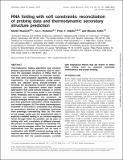RNA Folding with Soft Constraints: Reconciliation of Probing Data and Thermodynamic Secondary Structure Prediction
Author(s)
Mag Washietl, Stefan; Hofacker, Ivo L.; Stadler, Peter F.; Kellis, Manolis
DownloadKellis_RNA folding.pdf (2.500Mb)
PUBLISHER_CC
Publisher with Creative Commons License
Creative Commons Attribution
Terms of use
Metadata
Show full item recordAbstract
Thermodynamic folding algorithms and structure probing experiments are commonly used to determine the secondary structure of RNAs. Here we propose a formal framework to reconcile information from both prediction algorithms and probing experiments. The thermodynamic energy parameters are adjusted using ‘pseudo-energies’ to minimize the discrepancy between prediction and experiment. Our framework differs from related approaches that used pseudo-energies in several key aspects. (i) The energy model is only changed when necessary and no adjustments are made if prediction and experiment are consistent. (ii) Pseudo-energies remain biophysically interpretable and hold positional information where experiment and model disagree. (iii) The whole thermodynamic ensemble of structures is considered thus allowing to reconstruct mixtures of suboptimal structures from seemingly contradicting data. (iv) The noise of the energy model and the experimental data is explicitly modeled leading to an intuitive weighting factor through which the problem can be seen as folding with ‘soft’ constraints of different strength. We present an efficient algorithm to iteratively calculate pseudo-energies within this framework and demonstrate how this approach can be used in combination with SHAPE chemical probing data to improve secondary structure prediction. We further demonstrate that the pseudo-energies correlate with biophysical effects that are known to affect RNA folding such as chemical nucleotide modifications and protein binding.
Date issued
2012-01Department
Massachusetts Institute of Technology. Computer Science and Artificial Intelligence Laboratory; Massachusetts Institute of Technology. Department of Electrical Engineering and Computer ScienceJournal
Nucleic Acids Research
Publisher
Oxford University Press
Citation
Washietl, S. et al. “RNA Folding with Soft Constraints: Reconciliation of Probing Data and Thermodynamic Secondary Structure Prediction.” Nucleic Acids Research 40.10 (2012): 4261–4272.
Version: Final published version
ISSN
0305-1048
1362-4962